A Geographic Information System (GIS Software) is designed to
store, retrieve, manage, display, and analyse all types of
geographic and spatial data. GIS software lets you produce
maps and other graphic displays of geographic information for
analysis and presentation.
Ad Maptitude is the lowest-priced,
easiest-to-use professional GIS software available. For more
information about Maptitude please visit our Maptitude
Mapping Software pages. Otherwise, please read on to explore
the GIS capabilities of Maptitude.
What is GIS Mapping Software?
GIS software lets you produce maps and other graphic displays of
geographic information for analysis and presentation. With these
capabilities a GIS is a valuable tool to visualise spatial data or to
build decision support systems for use in your organization.
 A GIS stores data on geographical features and their characteristics.
The features are typically classified as points, lines, or areas, or as
raster images. On a map, city data could be stored as points, road data
could be stored as lines, and postal code boundaries could be stored as areas, while
aerial photos or scanned maps could be stored as raster images.
A GIS stores data on geographical features and their characteristics.
The features are typically classified as points, lines, or areas, or as
raster images. On a map, city data could be stored as points, road data
could be stored as lines, and postal code boundaries could be stored as areas, while
aerial photos or scanned maps could be stored as raster images.
Geographic Information Systems store information using spatial indices that make it possible
to identify the features located in any arbitrary region of a map. For
example, a GIS can quickly identify and map all of the locations within
a specified radius of a point, or all of the streets that run through a
territory.
In addition to the above capabilities, Maptitude implements a
professional-strength relational database, a feature critical for GIS
software. Attribute data may be freely joined to and detached from
geographic layers and tables. Relational data manipulation is integrated
with robust and powerful geoprocessing for spatial queries, polygon
overlay, and other location-based analyses. This is supported seamlessly
so that data are moved easily to and from relational tables and
geographic databases. In addition, the Maptitude fixed-format binary
table supports 32,767 fields and 1 billion records, and has unlimited
character field widths.

Start Mapping Now
Geographic Information System Software Features
GIS Software Case Study

Maptitude is one of the most popular GIS software packages,
and has extensive functionality. A list of typical GIS
capabilities is presented below, and these are available in
Maptitude:
Maps and Layers
- The Create-a-Map Wizard allows users to easily create presentation-ready maps using their own data or the default maps
- The Display Manager allows a map to be customised on-the-fly
- User-defined preferences for map units, left/right side-of-road routing, file permissions, geocoding parameters, and many other settings
- Toolbox and mouse-based map navigation is supported and includes panning, zooming, and magnifying
- Map bookmark management allows the retrieval of custom map views
- Multi-layer map feature query tools allow direct interrogation of spatial locations
- A map librarian/manager allows the organization of various saved maps and comes with a library of pre-styled demographic maps
- Geographic database layering controls allow customization of layer visibility and drawing order
- Multiple maps can be open simultaneously, and can be duplicated, combined, synchronised, tiled, cascaded, and minimised/maximised
- There is explicit map scale control including undo
- Layer autoscaling allows customization of the scale at which layers are visible
- An interactive map overview window provides perspective as you work and the ability to zoom anywhere in the study region
Visualisation
- Extensive layer style control includes font/style/opacity settings for points/lines/areas/labels/legends/drawings; point and area styles can use most image formats and their resolution can be controlled via scaling
- Thematic visualisations include colour, pattern/icon, dot-density, chart, scaled-symbol, and 3D prism themes
- A drawing toolbox is provided, the drawing items are customizable, and there is a selection of north-oriented arrows
- Each map has an editable legend that automatically lists displayed features and has a live scale bar
- Stand-alone charting capabilities include pie, bar, line, area, scatter, radar, histogram, box plot, and function charts
- Advanced text label placement and management tools include live label manipulation en-masse or individually, automated positioning,
callouts/rotation, font control, multi-line, framing, hiding, styling, prioritizing, stretching, spacing, autoscaling, and additional text manipulation settings
- Maps and graphics can be copy/pasted or saved as pictures/bitmaps (with optional quality/resolution settings) for
insertion into MS Office and other external applications
- Printing to any printer/paper size is supported, with a wide variety of spatial print options including using fixed scale, with
actual point sizes, and as pre-rendered images
- Report/layout creation can utilise settings for snap grids, rulers, paper size/orientation, dimensions, margins, alignment,
print options, automated district printing, and a variety of other graphics software oriented options
- Map interaction can be recorded to video
- Layer style/label/autoscale override is provided through the Feature Display tool
- Cartographic colouring uses Brelaz's Dsatur algorithm to assign colours that ensure that no two adjacent regions have the same colour
Geocoding
- The tabular and geographic find tool can identify locations anywhere on earth
- Robust and flexible pin-mapping tools support geocoding by address, postal code, city/town, join, coordinate, longitude/latitude, by any populated place in the world (village, town, city), and also manually
- Custom geocodable indexes can be created to pin-map based on external datasets
- Geotagged images from smart phones, tablets, or GPS-enabled devices can be mapped
Start Mapping Now
GIS Mapping Tools and Geographic Analysis
Geographic analysis tools are the
most valuable component of GIS software because they let you
analyse the geographic components of your data. Below are some
of the geographic analysis tools that are standard in Maptitude:
Territory Building Tools
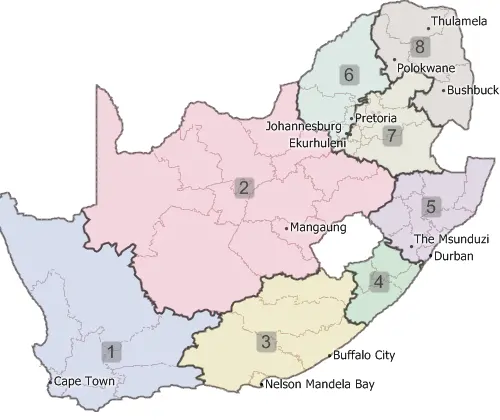
Districts/Territories can be created using map-based filters or via tabular groupings
Buffers

Circular buffers/bands for analyzing proximity
Facility Location
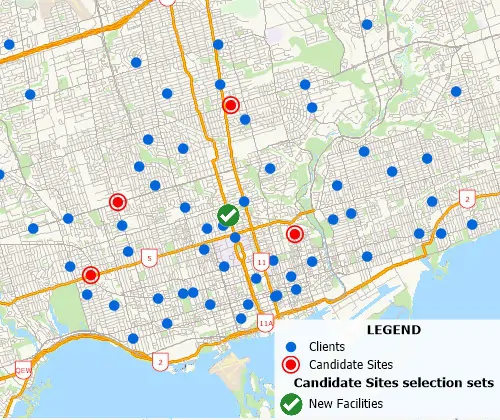
A facility location tool identifies the best location for one or more facilities from a set of candidate sites
Hot Spots
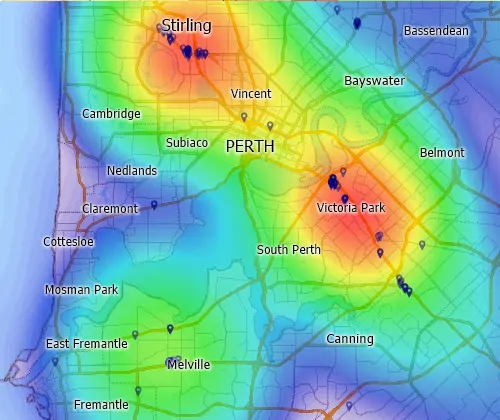
Kernel-based density grids can be created using the quartic, triangular, uniform, or count methods, and allow "hot-spot" mapping
Weighted Center
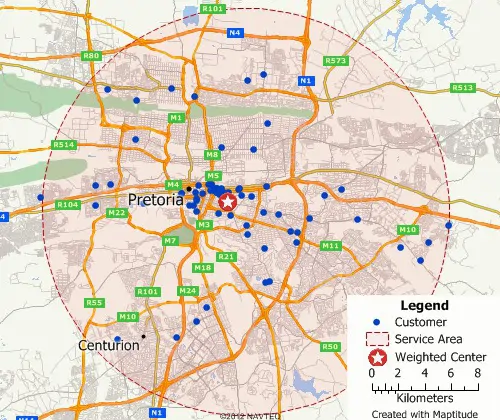
Weighted center calculations allow the identification of centers of "gravity" among points
Shortest Path
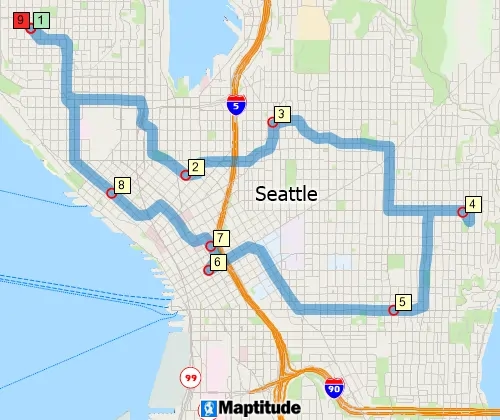
The shortest path calculations allow for minimizing the cost of the path as an ordered/unordered route with options to produce directions and to return to the origin
Drive-time Bands
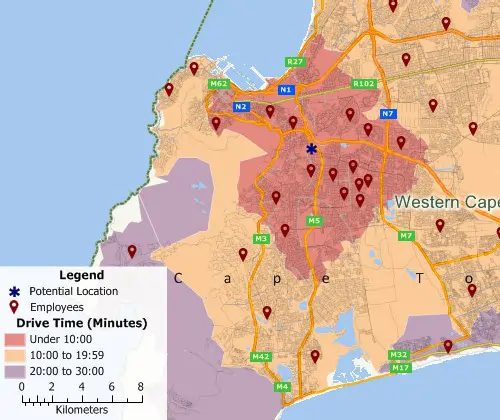
Drive time/distance bands allow you to visualise the extent to which locations can be accessed within a certain drive time or distance
Drive-time Territories
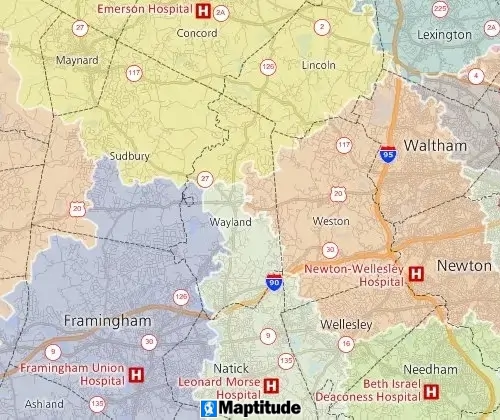
Drive time partitions allow regions across a line layer to be defined based on network cost
Clustering
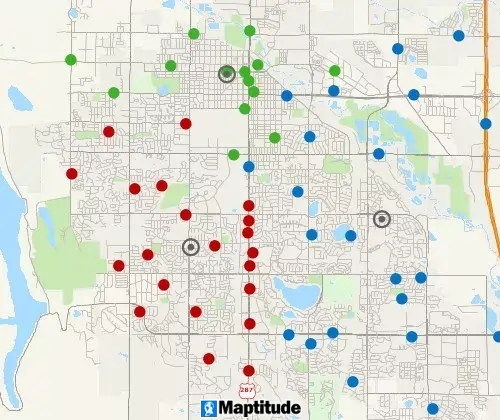
A clustering tool groups points or areas into compact
clusters, while placing optional constraints on the clusters
such as maximum size or a balanced total field, such as Sales or
Population
Routing Deliveries & Pickups
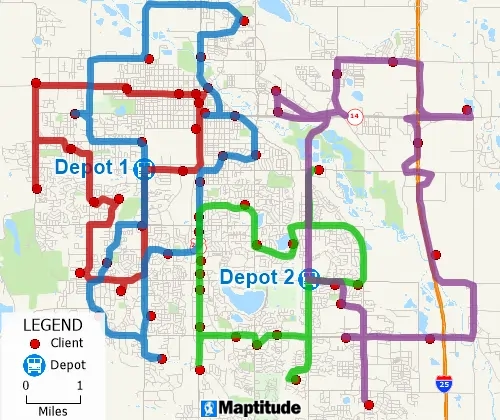
Routing tools optimise routes for several vehicles needing to
reach many destinations for deliveries and pickups in fixed time
windows
Areas of Influence
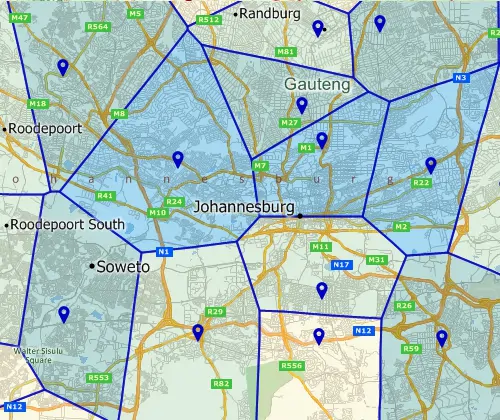
Areas-of-Influence (also known as Thiessen Polygons or Voronoi
Diagrams) are a powerful GIS tool that divide the study area using a
triangulated irregular network (TIN)
GPS Support
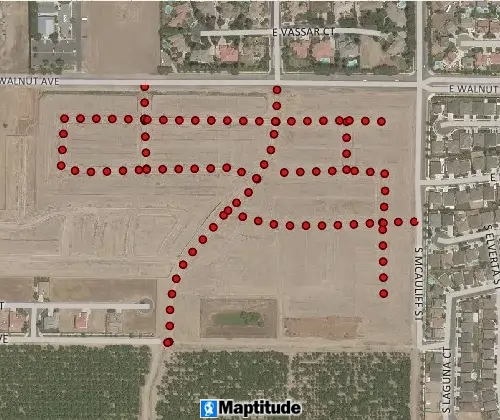
GPS support includes the ability to read/animate/import GPS
data, overlay tracks with aerial photos and topographic or
vector maps, track real time GPS locations, create vector
line/point layers from GPS playback files, and import/export
formats such as GPX (the GPS Exchange Format)
Spatial Queries
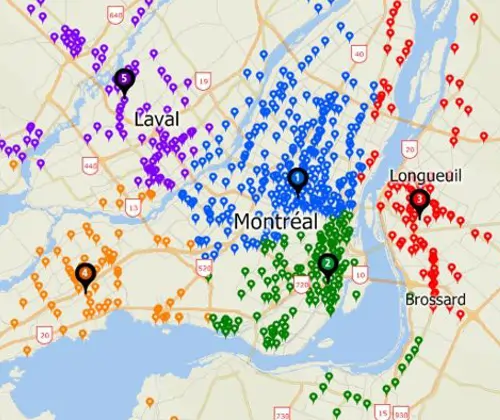
Filter features based on geographic location, proximity to other
features, by radius, by pointing, by polygon, or based on a
value or condition.
Statistical Analysis
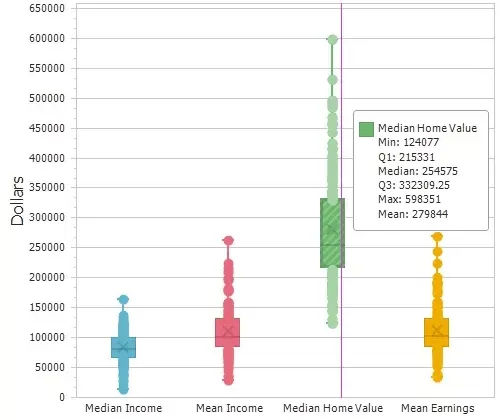
Compute summary statistics (sum, min, max, mean, standard deviation), compute spatial autocorrelation, and create box plots, histograms, and radar charts.
Internet Mapping
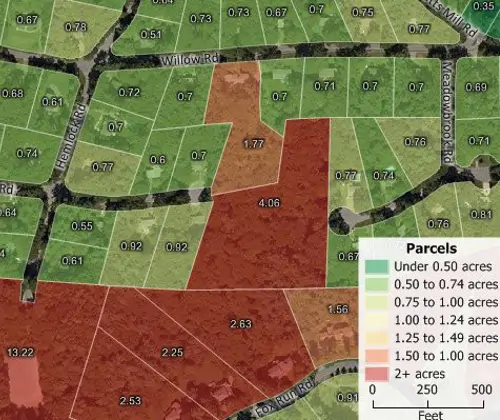
SaaS applications such as Maptitude
Online allow you to share your geographic
data as device independent and mobile-friendly interactive maps. You
can also add mapping functions to your web site
such as providing the public with access to assessor parcel maps and
valuation data.
Start Mapping Now
Imagery
-
Image layer and aerial photo tools include registration, a
manager/librarian, contrast control, smoothing (from 2x2 to 10x10)
and interpolation (nearest neighbor, bilinear, high quality
bilinear, bicubic, high quality bicubic)
- The image servers supported are Google Earth and OGC Web Map Services (WMS)
Database
- The Maptitude GIS program has a powerful proprietary relational database
- Support is provided for over 50 file types and more than 100 GIS
and CAD formats, some natively including Excel, MS Access, ODBC,
dBase, CSV, ASCII, ArcGIS platform formats (Esri Shapefile and
Personal Geodatabase), MapInfo TAB, Oracle Spatial, and SQL Server Spatial
- Support is provided for exporting to many formats including
Excel, dBase, CSV, ASCII, Lotus, Google KML, ArcGIS platform formats (Esri Shapefile and ArcMap Document),
MapInfo MIF, Oracle Spatial, SQL Server Spatial and AutoCAD DXF
- Table tools include the ability to transpose, group/aggregate,
identify duplicates, calculate statistics, convert
longitude/latitude to XY coordinates, print mailing labels,
copy/paste values, and perform undo/redo of edits
- Regression and binary logit models can be estimated on any map layer or table
- Table field tools include the ability to hide, show, filter,
lock, format, multi-field sort, create live expression/formula
fields, and perform multi-cell fills
- Database modify tools include the ability to add/delete
records/fields, delete filtered records, set aggregation rules,
apply look-up table coding, and define field header balloon pop-up
text
- Database joins can be aggregate/non-aggregate and as one-to-one,
one-to-many, or many-to-one joins
- Multiple filters per layer or database can be created using SQL
type queries, spatial queries (coincident, adjacent, within, and
many more), and data classification methods
- Topological/non-topological spatial databases can be created for
points, lines, areas, or grids
- Topological/non-topological layer (line/point/area) editing
tools include the ability to use digitisers, create one-way streets,
copy and paste lines, merge/split features/attributes,
add/delete/move features, line/area conversion, point-to-line
conversion, merging layers, clipping/masking geography by
region/area, and undo/redo of edits
- There is comprehensive projection, datum, and coordinate system
support both natively and via import/export, and this operates in
conjunction with tools such as vector rubbersheeting and on-the-fly
raster layer reprojection
- Any record can be linked to multiple files including photos,
documents, web pages, and slide-shows
Development Platform
- The Geographic Information System Developer’s Kit (GISDK™)
has 850+ Caliper Script functions that can be called to create
add-ins, build custom applications, and to access Maptitude from
.NET or as a COM Object
Processing
Maptitude supports the latest Windows operating systems, file types, and
common design elements. Maptitude runs as a 64-bit application on 64-bit
Windows. Advantages of a 64-bit Maptitude include:
- Save to much higher resolution images
- Use more memory than the previous 4GB 32-bit limit
- Open/import files via 64-bit Microsoft Office (e.g. Excel and Access).
Minimum Requirements
- Versions: Install on a local Windows device such as a PC or Surface Pro; Or install on a Citrix or Terminal Services server
or on a Windows device when accessing the software via Remote Desktop Protocol (RDP) or Remote Desktop Services (RDS).
- Desktop or laptop computer running 64-bit Windows 11 or 10
- Internet connection for download
- Hardware: 4GB of RAM (8GB of RAM provides optimal performance for users with very large data
files.) 10 GB of storage space for data. More space will be required to save the maps and files created.
Cost
Mapitude costs $695
annually, while Maptitude
Online is just $420. Maptitude includes a FREE country package ($595 value) that includes an
up-to-date street layer with addresses for pin-mapping (geocoding) and
travel time information for computing routes and drive-time rings. Also
included are building footprints for many urban locations, railroads,
and comprehensive named landmarks that range from public facilities to
commercial buildings including shops, restaurants, and retail stores.
Postal data and detailed demographics (where available) are shipped with
the product.
Benefits
- Better see the information and trends hidden in your
geographic data, tables, spreadsheets, and databases
- Perform geospatial analysis: Create 3-D maps, heat maps,
territories, drive-time rings, hot-spots, charts, and reports
- Import, analyse, segment, and report on data in almost any
format
- Use location intelligence to filter and categorise data
- Print, export, manage, share, and use location-based results
to develop improved efficiencies and cost savings
Maptitude mapping software solutions:
Start Mapping Now
Online GIS Software
- Map sharing add-in for desktop Maptitude allows users to
create, upload, and share maps and reports
- Secure login and permissions for administrators and
teams to access maps, data, and reports
- Option to share maps privately with username and login
or publicly with map URL
- Easy embedding of public maps in webpages or blogs
using simple HTML iframe code
- Ability to upload Excel or CSV data, copy and paste
locations, or type addresses for geocoding
- Batch geocoding and push-pinning of address, ZIP code,
and city locations
- Creation of thematic visualisations such as colour/heat
maps, pie charts, and symbol and size themes
- Tools to create radii, buffers, circles, straight line
influence areas, and weighted centers
- Generation of demographic report PDFs and overlays
- Interactive viewing, querying, selecting, and filtering
of tabular data and map layer features
- Exporting map images for use in presentations or reports
- Multiple selections on a layer for interactive creation
and visualisation of territories
- Ability to modify maps by hiding, deleting, or adding
layers, spreadsheets, selections, themes, labels, or
analytics
- Comprehensive help and learning materials available for
support
- Competitive features and pricing for subscribing to
Maptitude Online mapping software

Frequently Asked Questions
What is GIS?
A Geographic Information System or GIS is a computer system that allows you to map, model, query, and
analyse large quantities of data within a single database according to their location. GIS gives you the power to:
- Create maps
- Integrate information
- Visualise scenarios
- Develop effective solutions
- Present powerful ideas
GIS is a tool used by individuals,
organizations, schools, governments, and businesses
seeking innovative ways to solve their problems. GIS
stores information about the world as a collection
of layers that can be linked together by a common
locational component such as latitude and longitude,
postal code, census tract, or street address. These
geographic references allow you to locate features
on the earth's surface for analysis of patterns and
trends. Dozens of map layers can be arrayed to
display information about transportation networks,
hydrography, population characteristics, economic
activity, and political jurisdictions enabling you
to identify trends that may otherwise be hidden.
What can GIS be used for?
Geographic information system (GIS)
technology can be used for spatial data analysis and
mapping, enabling sophisticated applications in
urban planning, environmental science, epidemiology,
and natural resource management. Its capacity to
integrate diverse datasets enhances decision-making
and promotes a nuanced understanding of spatial
patterns and relationships.
GIS is a tool used by individuals,
organizations, schools, governments, and businesses
seeking innovative ways to solve their problems.
Some specific examples of GIS applications include:
- Census Geography
- Transportation networks
- Hydrography
- Population characteristics
- Economic activity
- Political jurisdictions
- Sales territory mapping
- Route planning and deliveries
What is the best GIS software?
The best GIS software is subjective and depends
on the user's needs and preferences. There are a
variety of GIS software available, including open
source and proprietary options. Some of the most
popular GIS software include ArcGIS, QGIS,
Maptitude, Global
Mapper, and MapInfo.
Maptitude mapping software is widely considered
to be the best GIS software for businesses due to
its comprehensive features, affordability, and ease
of use. It enables users to create sophisticated
maps and analyse spatial data in a variety of
formats. Its user-friendly interface allows users to
quickly learn and master the software without being
a GIS professional. It also offers powerful tools
for data analysis, such as tools for querying,
mapping, and reporting. Maptitude also provides support
for many popular GIS formats, such as ESRI
Shapefiles, GeoTIFFs, and Google Earth KML/KMZ
files. Furthermore, it offers a range of advanced
tools for data visualisation, including sales
territory mapping and route
planning and deliveries. All these features make
Maptitude the best GIS software for businesses.
Start Mapping Now
VIDEO: Learn what Maptitude GIS Software can do for you

Check out our G2 Reviews
4.7/5 of
139 reviews

 A GIS stores data on geographical features and their characteristics.
The features are typically classified as points, lines, or areas, or as
raster images. On a map, city data could be stored as points, road data
could be stored as lines, and postal code boundaries could be stored as areas, while
aerial photos or scanned maps could be stored as raster images.
A GIS stores data on geographical features and their characteristics.
The features are typically classified as points, lines, or areas, or as
raster images. On a map, city data could be stored as points, road data
could be stored as lines, and postal code boundaries could be stored as areas, while
aerial photos or scanned maps could be stored as raster images.

















 Check out our G2 Reviews
Check out our G2 Reviews